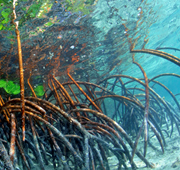A natural safety net
06 September 2012 | Article
As climate change increases the incidence of natural disasters like flooding and landslides, governments are looking for ways to protect their people and they’re finding that nature can help.
“Conserving ecosystems such as forests, river basins and mangroves — or ‘natural infrastructure’ — can help buffer the worst impacts of extreme weather,” says Kaia Boe of IUCN’s Ecosystem Management Programme.
Natural solutions are a cost-effective way of reducing the magnitude of hazards and protecting livelihoods. Healthy forests stabilise soil, wetlands absorb flood water and mangroves can protect coastal communities and their livelihoods.
“What we need to do now is better communicate the links between ecosystem management and reducing the risk of disasters as well as build partnerships that bring the conservation, development and humanitarian sectors together,” adds Boe.
Many conservation projects already include natural strategies to reduce risks but others could go further in integrating safeguards.
Examples of integrated approaches include combining coastal restoration with preparing for disasters and diversifying livelihoods, making space for excess water through wetlands restoration and responding to oil spills and natural hazards through greener recovery strategies.
All this will be discussed during the IUCN Congress where Members and partners with experience in integrating disaster risk reduction with ecosystem management will showcase their work.




